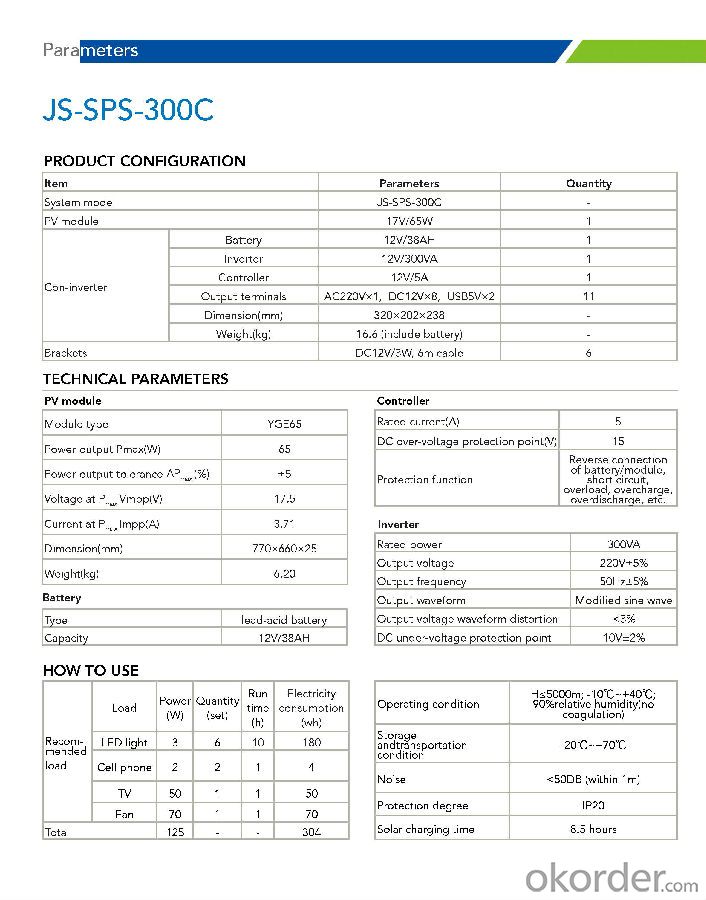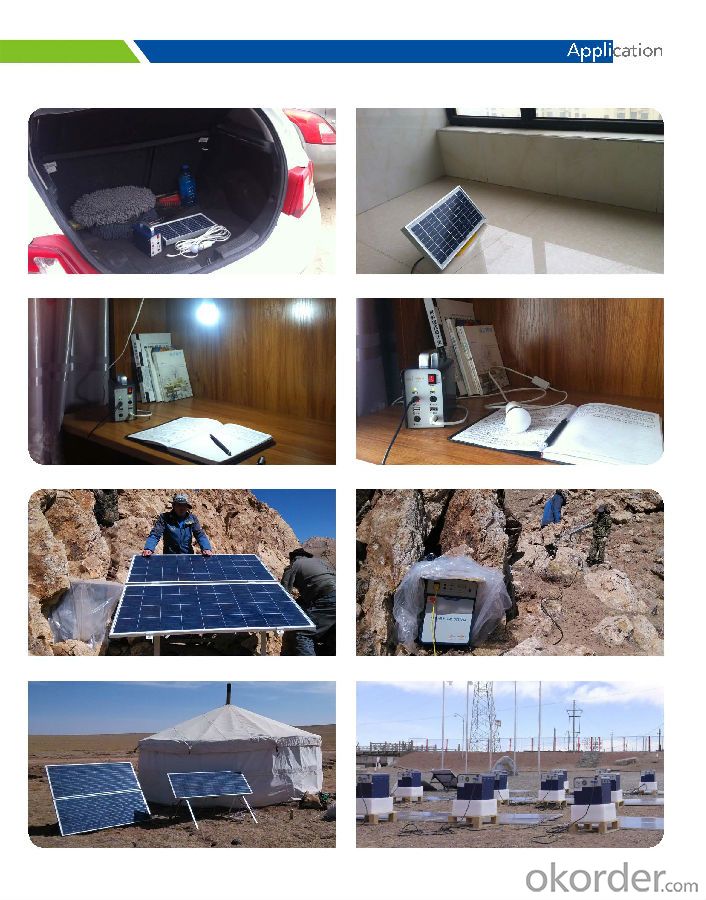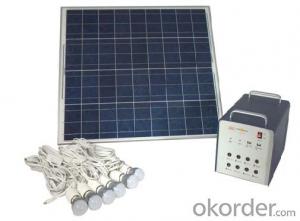Home Off-grid Solar Power System DC Lighting JS-SPS-300C
- Loading Port:
- Tianjin
- Payment Terms:
- TT OR LC
- Min Order Qty:
- 10 set
- Supply Capability:
- 10000 set/month
OKorder Service Pledge
Quality Product, Order Online Tracking, Timely Delivery
OKorder Financial Service
Credit Rating, Credit Services, Credit Purchasing
You Might Also Like
Off-grid Solar Power System
General Introduction
Solar power system provides alternating current and direct current, which is produced by the modules transforming solar power into power, to home lighting, household appliance and other DC appliance, such as cell phone and laptop.
Solar power system is widely used in area lack of power, for example house power supplying, monitoring, communication base, fire prevention in forest area, pasture and meadow, aquaculture etc.
We are dedicated to provide high quality off-grid PV products and systems to customers and has received a series of certificate, including ISO9001, TUV, UL, CE, CQC and RoHS.
Solar DC Lighting System
Multiple protection system, safe and reliable performance.
Integrated and portable design, easy operation.
DC5V, DC12V, AC220V output, wide range application.
Clean engergy, cycle use.
General Introduction
Solar power system provides alternating current and direct current, which is produced by the modules transforming solar power into power, to home lighting, household appliance and other DC appliance, such as cell phone and laptop.
Solar power system is widely used in area lack of power, for example house power supplying, monitoring, communication base, fire prevention in forest area, pasture and meadow, aquaculture etc.
We are dedicated to provide high quality off-grid PV products and systems to customers and has received a series of certificate, including ISO9001, TUV, UL, CE, CQC and RoHS.
Solar DC Lighting System
Multiple protection system, safe and reliable performance.
Integrated and portable design, easy operation.
DC5V, DC12V, AC220V output, wide range application.
Clean engergy, cycle use.



- Q:Can solar energy systems be used for powering electric bikes or scooters?
- Yes, solar energy systems can be used to power electric bikes or scooters. Solar panels can be installed on the roofs of buildings or on the bikes/scooters themselves to harness sunlight and convert it into electricity. This renewable energy source can charge the battery of the bike or scooter, providing an eco-friendly and sustainable power source for transportation.
- Q:Can solar energy systems be used for powering telecommunications networks?
- Indeed, telecommunications networks can be powered using solar energy systems. Solar power is a renewable and sustainable energy source that can be utilized to generate electricity for various purposes, including powering telecommunication infrastructure. Solar energy systems comprise solar panels that convert sunlight into electricity through the photovoltaic (PV) effect. These PV panels are commonly installed on rooftops, ground-mounted arrays, or integrated into the structure of telecommunication towers. They absorb sunlight during the day and transform it into direct current (DC) electricity. To make use of this electricity for powering telecommunications networks, an inverter is employed to convert the DC electricity into alternating current (AC), which is the standard form of electricity used in most electronic devices. The AC electricity produced by solar panels can then be utilized to power telecommunication equipment, such as base stations, antennas, transmitters, and receivers. There are numerous benefits associated with using solar energy systems to power telecommunications networks. Firstly, solar energy is abundant and accessible in almost all geographical locations, making it a feasible choice for powering remote or off-grid telecommunication sites. This reduces dependence on traditional grid electricity, which may be unavailable or unreliable in certain areas. Secondly, solar power is environmentally friendly, emitting no greenhouse gases during operation. By utilizing solar energy, telecommunication networks can significantly decrease their carbon footprint and contribute to the global shift towards clean energy sources. Furthermore, solar energy systems require low maintenance and have a long lifespan, offering a dependable and cost-effective solution for powering telecommunication infrastructure. Once installed, solar panels necessitate minimal upkeep and can last for 25-30 years or even longer with proper care. In conclusion, solar energy systems can effectively power telecommunications networks. They provide a sustainable and dependable source of electricity, reduce environmental impact, and offer a cost-effective solution for remote or off-grid telecommunication sites. With the growing emphasis on renewable energy, solar power is becoming an increasingly popular option for powering various sectors, including telecommunications.
- Q:What is a photovoltaic system?
- The technology known as a solar PV system, or photovoltaic system, converts sunlight into electricity. It utilizes solar panels to capture and convert the energy from the sun into direct current (DC) electricity. An inverter is then used to transform this DC electricity into alternating current (AC), which can be used in homes, businesses, and industries. At the heart of a photovoltaic system is the solar panel, which is composed of interconnected solar cells. These cells, typically made from semiconductor materials like silicon, produce an electric current when exposed to sunlight. The amount of energy generated by the solar cells is directly linked to the intensity of sunlight, making the system most effective in areas with ample sunshine. In addition to the solar panels, a photovoltaic system includes other essential components. These include mounting structures to secure the panels, a solar charge controller to regulate electricity flow, batteries for energy storage, and an inverter to convert DC electricity to AC electricity. The system may also incorporate a meter for measuring electricity generation and consumption. Photovoltaic systems offer numerous advantages. They provide a clean and renewable energy source, reducing reliance on fossil fuels and minimizing environmental impact. They also offer long-term cost savings as they generate electricity without ongoing fuel costs. Furthermore, photovoltaic systems can be scaled, allowing for installation on a small scale for residential use or on a larger scale for commercial or utility applications. Overall, photovoltaic systems have gained popularity as a sustainable and efficient method of generating electricity. Their widespread adoption has contributed to the shift towards a greener and more environmentally friendly energy landscape.
- Q:How do solar energy systems reduce carbon emissions?
- Solar energy systems reduce carbon emissions by harnessing energy from the sun and converting it into electricity without burning fossil fuels. This renewable source of energy replaces the need for electricity generated from coal, oil, and natural gas, which emit carbon dioxide and other greenhouse gases into the atmosphere. By using solar energy, we can significantly reduce our dependence on carbon-intensive power sources, thereby mitigating the harmful effects of climate change and helping to create a cleaner, more sustainable future.
- Q:Can solar energy systems be used in powering wineries or breweries?
- Yes, solar energy systems can be used to power wineries or breweries. Solar panels can be installed on the roofs of the buildings or in nearby open areas to generate clean and renewable electricity. This can help wineries and breweries reduce their dependence on fossil fuels, lower their energy costs, and contribute to a more sustainable and environmentally-friendly operation.
- Q:Can solar energy systems be used for powering electric vehicle sharing programs?
- Yes, solar energy systems can be used to power electric vehicle sharing programs. Solar energy is a renewable and sustainable source of power, making it an ideal solution for reducing carbon emissions and promoting clean transportation. By installing solar panels and utilizing the energy they produce, electric vehicle sharing programs can operate on clean and green energy. This eliminates the reliance on fossil fuels and reduces the overall environmental impact of the program. Additionally, solar energy systems can provide a reliable and cost-effective source of power for charging electric vehicles, making it an efficient and practical solution for powering these programs.
- Q:Can solar energy systems be used in powering research laboratories or scientific facilities?
- Yes, solar energy systems can be used to power research laboratories or scientific facilities. Solar panels can be installed on the roofs or grounds of these facilities to convert sunlight into electricity. This renewable energy source can provide a sustainable and reliable power supply, reducing dependence on traditional electricity grids and minimizing the carbon footprint of these facilities. Additionally, solar energy systems can be integrated with battery storage solutions to ensure continuous power supply even during periods of low sunlight or power outages.
- Q:Can solar energy systems be connected to the grid?
- Yes, solar energy systems can be connected to the grid. This is known as grid-tied or grid-connected solar power. When a solar energy system is connected to the grid, it allows for the excess electricity generated by the system to be sent back to the grid, while also drawing power from the grid when the solar panels are not producing enough electricity. This grid connection enables homeowners and businesses to benefit from net metering, where they receive credits for the excess electricity they supply to the grid, resulting in reduced energy costs.
- Q:How do solar energy systems affect wildlife?
- Solar energy systems can have both positive and negative impacts on wildlife. On the positive side, solar energy systems can help reduce greenhouse gas emissions, which in turn reduces the impact of climate change on wildlife habitats. Additionally, solar panels can provide shade and shelter for certain species, and the land beneath solar installations can be used for biodiversity-friendly practices, such as planting native vegetation. However, there are also potential negative impacts, such as habitat disruption and loss due to land use changes and infrastructure development. It is important to carefully plan and design solar energy systems to minimize these negative effects and ensure the protection of wildlife.
- Q:Can solar energy systems be used for powering remote communication systems?
- Yes, solar energy systems can be effectively used for powering remote communication systems. Solar panels can convert sunlight into electricity, which can be stored in batteries for use during cloudy periods or at night. This makes solar energy a reliable and sustainable power source for remote communication systems, such as radio towers, weather stations, or even satellites, where traditional power sources may not be easily accessible.
1. Manufacturer Overview |
|
|---|---|
| Location | |
| Year Established | |
| Annual Output Value | |
| Main Markets | |
| Company Certifications | |
2. Manufacturer Certificates |
|
|---|---|
| a) Certification Name | |
| Range | |
| Reference | |
| Validity Period | |
3. Manufacturer Capability |
|
|---|---|
| a)Trade Capacity | |
| Nearest Port | |
| Export Percentage | |
| No.of Employees in Trade Department | |
| Language Spoken: | |
| b)Factory Information | |
| Factory Size: | |
| No. of Production Lines | |
| Contract Manufacturing | |
| Product Price Range | |
Send your message to us
Home Off-grid Solar Power System DC Lighting JS-SPS-300C
- Loading Port:
- Tianjin
- Payment Terms:
- TT OR LC
- Min Order Qty:
- 10 set
- Supply Capability:
- 10000 set/month
OKorder Service Pledge
Quality Product, Order Online Tracking, Timely Delivery
OKorder Financial Service
Credit Rating, Credit Services, Credit Purchasing
Similar products
New products
Hot products
Related keywords






























